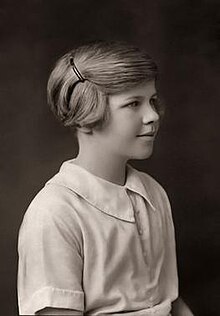Venetia Burney
Venetia Burney | |
|---|---|
 Venetia Burney aged 11 | |
| Born | Venetia Katharine Douglas Burney 11 July 1918 |
| Died | 30 April 2009 (aged 90) Banstead, England |
| Known for | Naming Pluto |
| Spouse |
Edward Maxwell Phair
(m. 1947–2006) |
| Children | Patrick Phair |
| Parents |
|
| Relatives | Falconer Madan, grandfather |
Venetia Katharine Douglas Burney (married name Phair, 11 July 1918 – 30 April 2009) was an English accountant and teacher. She is remembered as the first person to suggest the name Pluto for the dwarf planet discovered by Clyde Tombaugh in 1930. At the time, she was 11 years old.
Biography[edit]
Venetia Burney was the daughter of Rev. Charles Fox Burney, Oriel Professor of the Interpretation of Holy Scripture at Oxford, and his wife Ethel Wordsworth Burney (née Madan). She was the granddaughter of Falconer Madan (1851–1935), Librarian of the Bodleian Library of the University of Oxford.[1] Falconer Madan's brother, Henry Madan (1838–1901), Science Master of Eton, had in 1878 suggested the names Phobos and Deimos for the moons of Mars.[2]
On 14 March 1930, Falconer Madan read the story of the new planet's discovery in The Times, and mentioned it to his granddaughter Venetia. She suggested the name Pluto – the Roman God of the Underworld who was able to make himself invisible − and Falconer Madan forwarded the suggestion to astronomer Herbert Hall Turner, who cabled his American colleagues at Lowell Observatory. Clyde Tombaugh liked the proposal because it started with the initials of Percival Lowell who had predicted the existence of Planet X, which they thought was Pluto because it was coincidentally in that position in space. On 1 May 1930, the name Pluto was formally adopted for the new celestial body.[3] Whether she was really the first person to propose the name has been doubted on plausibility grounds,[4] but the historical fact is that she was credited as such.
Most news coverage done at the time of the discovery of Pluto didn't mention her and the role she played in terms of naming Pluto was mostly forgotten about until a 1984 article from Sky & Telescope publicized her role.[5]
Burney was educated at Downe House School in Berkshire and Newnham College, Cambridge, where she studied economics from 1938-41.[6] After graduation she became a chartered accountant. Later she became a teacher of economics and mathematics at girls’ schools in southwest London[7] teaching until she retired in the 1980s.[8] She was married to Edward Maxwell Phair from 1947 until his death in 2006. Her husband, a classicist, later became housemaster and head of English at Epsom College. She died on 30 April 2009, aged 90, in Banstead in Surrey.[7] She was buried at Randalls Park Crematorium in Leatherhead in Surrey.
Only a few months before the reclassification of Pluto from a planet to a dwarf planet, with a debate going on about the issue, she said in an interview, "At my age, I've been largely indifferent [to the debate]; though I suppose I would prefer it to remain a planet."[3]
Legacy[edit]
The asteroid 6235 Burney and Burney Crater on Pluto were named in her honour.[9][10] In July 2015 the New Horizons spacecraft was the first to visit Pluto and carried an instrument named Venetia Burney Student Dust Counter in her honour.[11] Mihaly Horanyi, Principal Investigator for the instrument, and Alan Stern visited Mrs Phair at home to present her with a plaque, certificate, and spacecraft model.[12]
Massachusetts rock band The Venetia Fair came up with their name after reading about Venetia Phair, shortly after Pluto was reclassified as a dwarf planet.[13]
References[edit]
- ^ "Venetia Phair". Daily Telegraph. 5 May 2009. Retrieved 11 May 2009.
- ^ "Proceedings of the Royal Astronomical Society". The Observatory. 53: 193–201. July 1930. Bibcode:1930Obs....53..193. Retrieved 21 April 2015.
- ^ a b Rincon, Paul (13 January 2006). "The girl who named a planet". Pluto: The Discovery of Planet X. BBC News. Retrieved 12 April 2007.
- ^ Geoff Nunberg. Another Plutonian casualty? Language Log. 27 August 2006.
- ^ Stromberg, Joseph (10 July 2015). "How a 12-year-old girl gave Pluto its name". Vox. Retrieved 1 January 2024.
- ^ Newnham College Register, vol II. Newnham College. 1981. p. 179.
- ^ a b Grimes, William (10 May 2009). "Venetia Phair Dies at 90; as a Girl, She Named Pluto". The New York Times. Retrieved 11 May 2009.
- ^ "Venetia Phair dies at 90; as a girl, she named Pluto". Los Angeles Times. Associated Press. 11 May 2009. Retrieved 1 January 2024.
- ^ "JPL Small-Body Database Browser". NASA. Retrieved 21 April 2015.
- ^ "Pluto: dwarf planet's surface features given first official names". The Guardian. 8 September 2017. Retrieved 8 September 2017.
- ^ "Pluto-Bound Science Instrument Renamed for Girl Who Named Ninth Planet". NASA. 30 June 2006. Archived from the original on 9 March 2015. Retrieved 21 April 2015.
- ^ "New Horizons Team Remembers Venetia Phair, the 'Girl Who Named Pluto'". spaceref.com. 8 May 2009. Retrieved 16 February 2022.
- ^ "Exclusive Interview: The Venetia Fair". Neck Deep Media. Archived from the original on 21 July 2015. Retrieved 21 April 2015.



